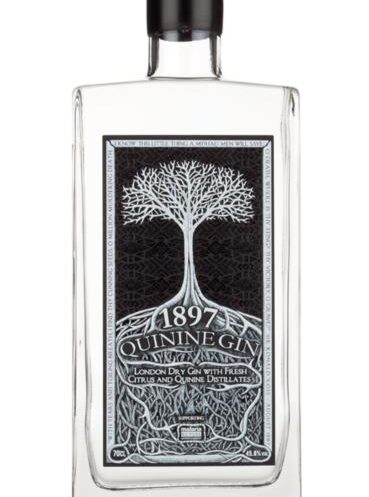If the holidays are a time for thinking truly about others first, than 1897 Quinine Gin is an apt review for this time of year.
£5 of every sale will be donated to Malaria No More UK, an organization dedicated to fighting Malaria around the world and making this preventable disease a thing of the past.
The quinine in tonic water is an effective anti-Malarial agent, and it was taken by peoples in areas where Malaria is endemic to prevent and fight the virulent disease. The bitterness of cinchona bark (one of the primary sources for Quinine) meant that better ways to consume it needed to be devised. This is the culture around where the Gin and Tonic arose. This is perhaps more TL;DR as the story of Quinine, Malaria and Gin is enough for a book in and of itself.
1897 Quinine Gin is vacuum distilled at low temperatures, and includes cinchona among a more traditional list of gin botanicals including four kinds of citrus and two kinds of grapefruit.
Tasting Notes
Very classic style nose, but quite aromatically intense. Juniper, citrus— maybe some white grapefruit— and an earthy underpinning of angelica, coriander and cinnamon spice.
Tasted neat from the bottle, citrus at first. Lovely lemon zest, white grapefruit fruit, with juniper/baking spice mid palate. About halfway through there’s few surprises. It’s very traditional and seems to be following a paint by numbers sort of approach.
But this is where things change up a bit. Just as some of the baking spice low notes of nutmeg and angelica seem to take over, a clean, dry, bitterness— not altogether different at first from your usual juniper astringency— it builds and evolves, almost catching you off guard when the cinchona bitterness catches at the back of the palate. The finish is dry and slightly nutmeg/cinnamon. Moderately long, its mostly classic but the dryness is different and very much reminiscent to me of drinking Fever Tree’s Indian Tonic straight from the bottle. Quite lovely, and it’s remarkable how a little bit of quinine in the gin can do for the gin what a Gin and Tonic usually brings .
Cocktails
I actually don’t recommend the Gin and Tonic here, because it’s already bringing that bitter note to the picture. I suggest mixing 1897 Quinine Gin and looking for drinks that could use a touch of bitterness to it. Similarly, the Gin Fizz comes across a bit too Gin-and-tonic like. In other words, good, but not the best showcase for this gin.
I really liked the addition of the quinine note with a Gin and Juice style mixed drink. But the Martini and Tom Collins were two where I felt like that additional bitterness at the end really created something new, exciting, and delicious. The Tom Collins in particular has the subtlety of just adding a touch of tonic water to the original. Quite good.
Overall, mixing it had an interesting affect in that most mixed drinks with soda tasted like you might have just added a bit of tonic. Cocktails are certainly where the greatest potential exists for playing with the new note and the quinine finish. Bartenders I think could have a lot of fun making classics with this while supporting a good cause.
Overall
It’s rather straightforward with a lot of classic gin character, but I think that finish augmented with just a touch of tonic-water like bitterness transforms 1897 Quinine Gin into something that can be a lot of fun to play with. Most people who like their gin and tonics or consume their gin in mixed drinks only will likely not be getting the most from this gin. If that’s your gin drink of choice, I recommend looking elsewhere at this price point. But if you’re a Martini drinker whose looking to combined the worlds of Gin and Tonic and Martinis while preserving the perfectly clarity of the drink— this could be the gin for you.

